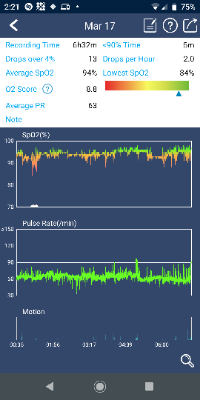Getting a Good Night's Sleep
What is sleeping to you? Seems so freakin' simple - right?
"Get a good nights sleep" we are told. To be healthy and burn fat properly and recover from hard workouts, you must have at least 7 hours and preferably 8 hours of sleep. But, don't sleep too much!!!
A little epiphany I had was that 1) laying in bed is not the same as 2) sleeping. Obvious, I know. But, honestly, I had not separated those two in my mind completely.
On an extended visit with my daughter and son-in-law we talked a little about their use of the Apple Smart Watch for sleep monitoring. And, my daughter-in-law said at my daughter's wedding, that she used some kind of sound monitoring app that worked OK. I looked at all kinds of sleep monitoring devices and got very confused. Let's just say I am not an Apple Fanboy and was looking for an alternative. One person had good luck with the Fitbit and I was leaning that way.
On my yearly doctor visit, I mentioned to him that my snoring level had increased based on my wife's complaints and that more than once I had a dream a bear was after me, woke up, and realized the bear was me snoring! Haha. He ordered a home test service to deliver an Oximeter that would record O2 levels while sleeping. A light bulb went off! An Oximeter - that made a ton of sense.
So, I didn't know how long that test would take and I started searching in earnest for my own O2 measurement device. After reading a bunch of reviews, both technical and consumer, I settled on the Wellue O2 Ring. It is easy to use. Install the device software on your computer and phone. Plug into the USB of your computer. Then tell it to sync clocks. Check the vibration alarm levels when the ring will tell you if your O2 or pulse is low. I left mine at the defaults of pulse alarm off and O2 alarm vibrate <88%. On/off is automatic based on if you have it on/off your finger.
When removing the ring in the morning, if the phone app is open it auto-downloads the night's O2 and pulse readings in less than 30 seconds. There are graphs of O2 levels, pulse readings and marks on the graph where the ring vibrated in the night because the O2 level went less than 88%. Then I plug it in using the supplied USB cable and download to the software on the computer. You get a more detailed report on the PC but essentially the same info. The computer software provides a print ready report in PDF you could bring to a doctor's visit.
Here is what the phone app displays. Top right is an overall score for the night that is graphed in a History page to show your trend from day-to-day.
This is the first page of the daily report the computer software generates. I found the graph showing the percentage of SPO2 readings in the three bars indicating <95%, 90-95%, and .90% to be the most useful. The subsequent pages show detailed graphs of O2 percentage and pulse along with indicators where the vibration alarm went off.What to do with all this data? I felt lost the first couple days. Then as I started to look at it each day it all made more intuitive sense. My feeling was I had probably achieved most of what was possible from the vibration alarm helping change sleep behavior. I did some google searches on improving sleep quality and one item that came up in several lists was to try a different pillow.
My pillow was old. I had bought a one six months ago but it was too thick and my neck hurt after waking up so I had gone back to a very soft and thin pillow. I tried the new one again and while my sleep improved that night I had the sore neck again. So, after many searches I bought the EPABO Contour Memory Foam Pillow. From what I read this seemed like a decent fix for my symptoms and was inexpensive on Amazon at around $40.
The first night was a big improvement with my minutes of O2 < 90% dropping from an average of 4 minutes down to about 1 minute. This has held fairly consistent over four days now.
In summary, still only a few data points and things could change. My early analysis is that the O2 Ring and pillow have been more than worth the ~$200 I have spent. I am feeling more rested. The data from the O2 Ring seems consistent except I do question the low pulse readings at night which could be related to hand position and the fact my left shoulder has some issues that I am awaiting to start PT for. I am going to experiment with the ring on the right hand and try thumb and index finger to see if those changes make any difference,
The O2 readings seem to be consistent which is the most important to me. When the alarm goes off and I am cognizant of that, each time I made an adjustment in position or breathing, the alarm turned off and my sleep resumed at a better O2 percentage.
Overall, I recommend the O2 Ring. Pillows are so personal, I hesitate to recommend that one - for me, it definitely has improved my comfort and sleep.


Comments